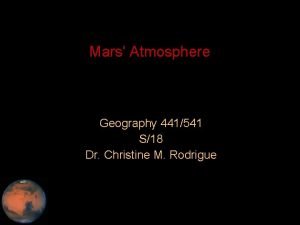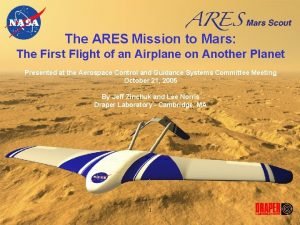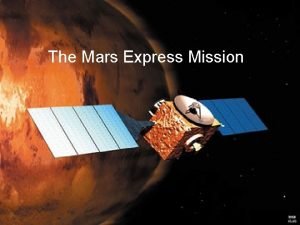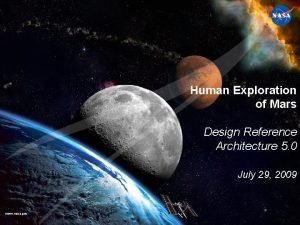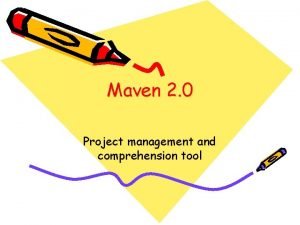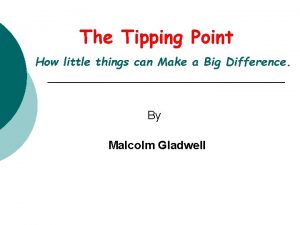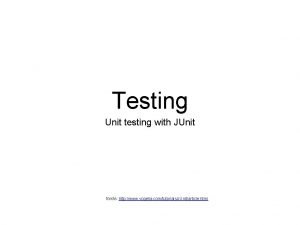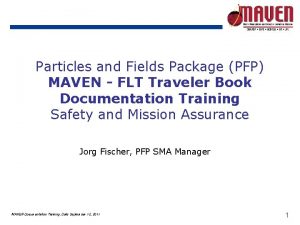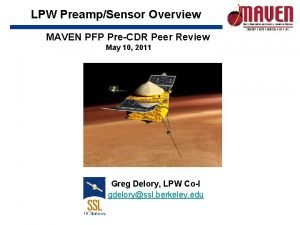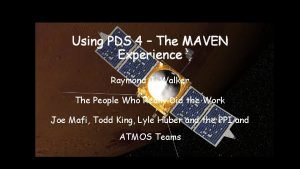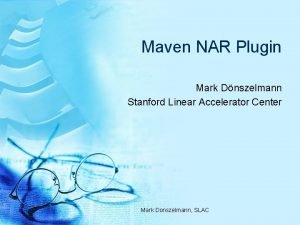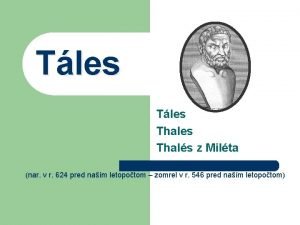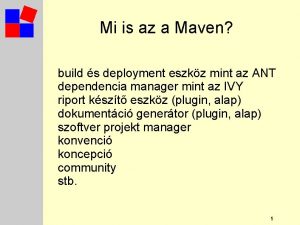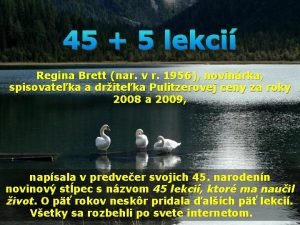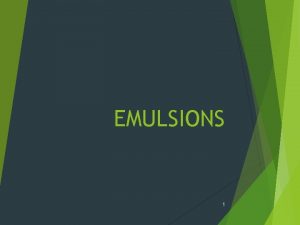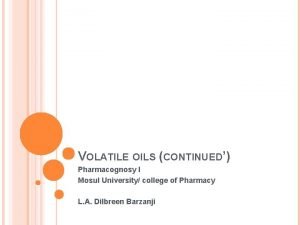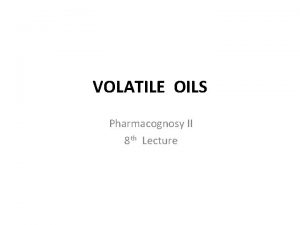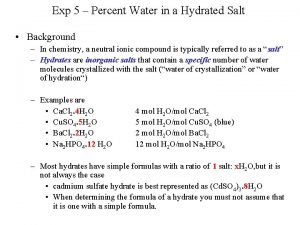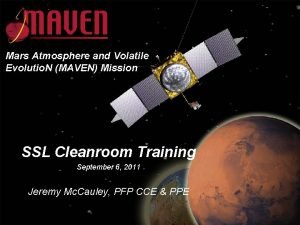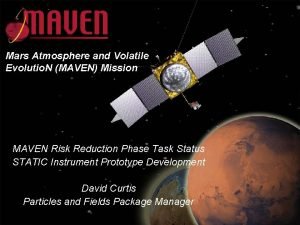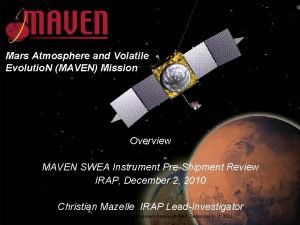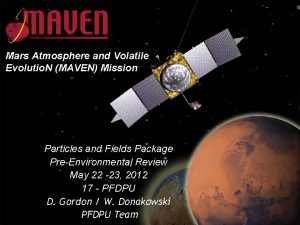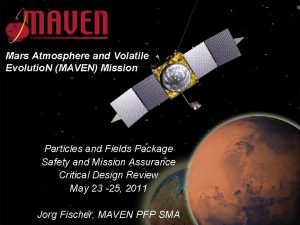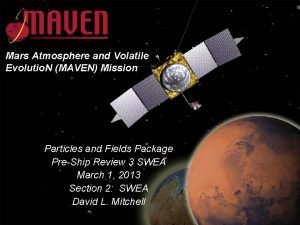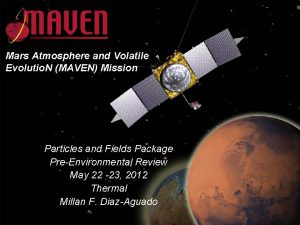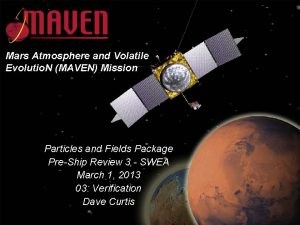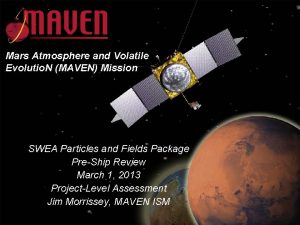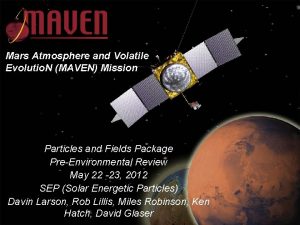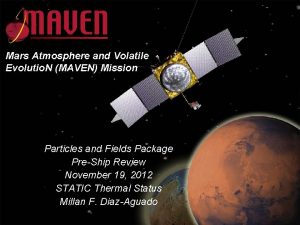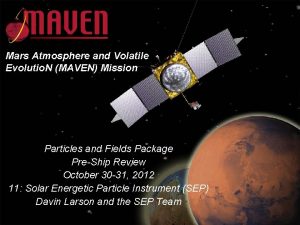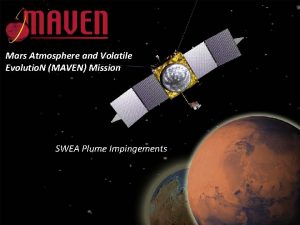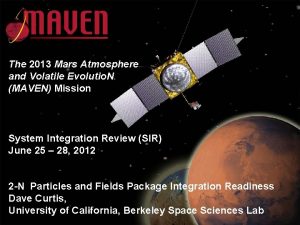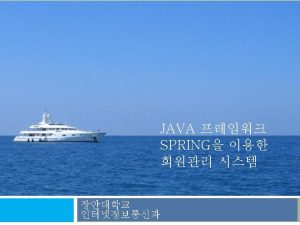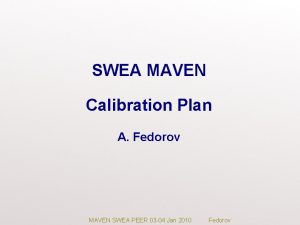Mars Atmosphere and Volatile Evolutio N MAVEN Mission
























- Slides: 24

Mars Atmosphere and Volatile Evolutio. N (MAVEN) Mission Context and Scientific Objectives MAVEN SWEA Instrument Peer Review February 3, 2010 Christian Mazelle 04/06/2021 MAVEN-SWEA instrument peer review / CESR 1

The PFP Ensemble LPWEUV SWIA Solar Wind Ion Analyzer (SWIA) - SSL Solar Wind Electron Analyzer (SWEA) – CESR / SSL Langmuir Probe and Waves (LPW) – LASP / SSL Plus Extreme Ultra-Violet (LPW-EUV) - LASP LPW SWEA SEP (sunward FOV not shown) MAG Solar Energetic Particle Detector (SEP) - SSL Magnetometer (MAG) – GSFC Supra-Thermal and Thermal Ion Composition (STATIC) - SSL 04/06/2021 MAVEN-SWEA instrument peer review / CESR STATIC 2

The MAVEN Science Instruments Mass Spectrometry Instrument Particles and Fields Package Remote-Sensing Package The MAVEN instruments are all closely based on similar instruments that have flown on previous missions. 04/06/2021 MAVEN-SWEA instrument peer review / CESR 3

SWEA Instrument Accommodation Solar Wind Electron Analyzer (SWEA) Boom location: • Separation from s/c potentials • Large, clear field of view • Sensor head in shadow • Electronics box in sunlight 04/06/2021 MAVEN-SWEA instrument peer review / CESR 4

SWEA Measurement Requirements Systems Requirements Assessment 2009 -8 -11 • SWEA measures properties of solar wind electrons that can drive escape: – Energy distributions of solar wind, magnetosheath, and ionospheric electrons from 10 to 1000 e. V to determine the electron impact ionization rate, with an energy resolution (~25%) sufficient to distinguish ionospheric photoelectrons from solar wind electrons. Electron angular distributions to determine magnetic topology, with the ability to spatially resolve magnetic cusps (horizontal length scales of ~100 km). • Derived Level 3 measurement requirements: ID Title Parent ID Description PF 65 SWEA Flux Range MRD 58 SWEA shall measure energy fluxes from 1 E 4 to 1 E 8 e. V/cm 2 -sec-ster-e. V PF 66 SWEA Sensitivity MRD 59 SWEA shall have a geometric factor > 0. 005 cm 2 -ster PF 67 SWEA Energy Range MRD 60 SWEA shall measure electrons from 10 - 1000 e. V PF 68 SWEA Energy Resolution MRD 60 SWEA shall have energy resolution d. E/E of at least 25% PF 69 SWEA Time Resolution MRD 61 SWEA shall have time resolution of at least 20 seconds PF 70 SWEA Angular Resolution MRD 62 SWEA shall have angular resolution of at least 45 degrees PF 71 SWEA FOV MRD 63 SWEA shall have a FOV which covers at least 50% of the sky 04/06/2021 MAVEN-SWEA instrument peer review / CESR 5

Solar Wind Electron Analyzer (SWEA) Instrument Accommodation SWEA • Large field of view with minimal obstructions • Conducting, grounded surfaces in the field of view • Sensor head in shadow (electronics box sunlit) • Simultaneous magnetic field measurements Hemispherical top-hat electrostatic analyzer with deflection system Mass Power Energy range Energy res. Field of view Angular res. Geom. factor 1. 4 kg 1 Watt 5 e. V - 6 ke. V 18% (DE/E)* 360° × 130° 22. 5° × 7° 0. 008 cm 2 ster *adjustable from 9% to 18% Measurements Science Objectives • Energy and angular distributions of solar wind and magnetosheath electrons and ionospheric photoelectrons: 0 – 3 ke. V (full angle range) 3 – 6 ke. V (limited angle range) • Continuous measurements throughout the orbit with 10 -sec (20 -40 km) resolution to resolve magnetic cusps and bow shock • Electron impact ionization rate (total ionization rates, pickup ions) • Magnetic field topology (with MAG) • Plasma regime (solar wind interaction) • Photoelectron energy spectra (photochemistry) • Auroral electron features 04/06/2021 MAVEN-SWEA instrument peer review / CESR 6

MGS Electron Impact Ionization • Magnetic Pileup Region • Ionosphere 04/06/2021 MAVEN-SWEA instrument peer review / CESR 7

MARTIAN PHOTO-ELECTRONS ESCAPE Mars Express Shadow 2, 35 RM ESCAPE Photo-ionization of CO 2 by solar h @ 304 Å PEB h -electrons MPB 5 R (MSO) 4 3 2 1 0 -3 -2 04/06/2021 -1 0 X (MSO) 1 2 Escape associated to heavy ions (M> 16) MAVEN-SWEA instrument peer review / CESR 8

Resolving Photoelectron peaks 04/06/2021 MAVEN-SWEA instrument peer review / CESR 9

Electron differential flux in the different regions of the Martian environment (MEx) Dayside magnetosheath Maximum energy flux estimate 1. 108 e. V cm-2 sr-1 e. V-1 For 16 azimuthal sectors and Maximum count rate of 105 s-1 gives a geometrical factor of one sector GF 16=1. 10 -3 cm 2 sr e. V/e. V Plasmasheet Stereo SWEA: GF 16=2. 10 -3 (ideal) = 5. 10 -4 (real) MGS ER: GF 16=4. 6 10 -4 for E<100 e. V MEx ELS: GF 16=4. 7 10 -5 All far from saturation 04/06/2021 MAVEN-SWEA instrument peer review / CESR 10

Hardware Implementation: Baseline STEREO SWEA Design 04/06/2021 MAVEN-SWEA instrument peer review / CESR 11

Instrument geometry 04/06/2021 MAVEN-SWEA instrument peer review / CESR 12

Geometrical Factor ~4 less Real less than ideal one due to multiplication by real grids transparency (interference between two entrance grids), MCP efficiencies and grid support shadow. Values still ok for near Mars measurements. But need to reduce of the instrument down to ~10% at least for low energy range to expect resolving CO 2 photoionisation peaks around 20 e. V. 04/06/2021 MAVEN-SWEA instrument peer review / CESR 13

Variation of energy resolution of the sensor at low energy can be controlled by varying the voltage bias U 0 between the internal and external grids: where and is the generic energy resolution (0. 175) is the incident energy of the electron Thus to increase the energy resolution about 2 times, we have to apply 04/06/2021 MAVEN-SWEA instrument peer review / CESR 14

Variation of energy resolution: simulation (1) numerical simulation using: trajectory examples is decreased by a factor 1. 7 and geometrical factor by a factor 4. No other significant degradation of the sensor properties are found 04/06/2021 MAVEN-SWEA instrument peer review / CESR 15

Variation of energy resolution: simulation (2) 04/06/2021 MAVEN-SWEA instrument peer review / CESR 16

Validation using Mex measurements (1) 04/06/2021 MAVEN-SWEA instrument peer review / CESR 17

Validation using Mex measurements (2) Total Count rates Simulated count rates Reduction of count rates with increase of energy resolution 04/06/2021 MAVEN-SWEA instrument peer review / CESR 18

Heritage • CESR has a long heritage of successful hardware collaboration with SSL: ISEE, GIOTTO, WIND 3 D-P, MGS, CLUSTER-CIS, STEREO • Instruments lifetime very often largely overshooted the baseline: WIND, MGS (9 years instead of 2), CLUSTER-CIS (10 years of operation soon), Mars Express, Venus Express 04/06/2021 MAVEN-SWEA instrument peer review / CESR 19

MAVEN / SWEA Stereo Swea instrument basis • Instrument SWEA : design already flying on STEREO • Engineering model available in CESR for tests • Calibration facility available in CESR • Most of Stereo technical team expertise available • Stereo Swea data analysis team feedback • All tools available for Maven/Swea instrument fabrication • Same companies will be in charge of Maven instrument fabrication (electronics, mechanics, environmental tests) • Maven Swea fully funded by Cnes until 2016 04/06/2021 MAVEN-SWEA instrument peer review / CESR 20

SWEA: status • Cnes contract: to deliver same instrument as for Stereo (limited funding and manpower). • Heritage from stereo in flight data. Better understanding of the instrument. Minor h/w modifications to implement on Maven SWEA. • Minor changes only deal with: - geometrical factor and energy resolution at low energy. - improve low energy response. - interfaces to be discussed with SSL. - improve reliability (higher screening than for Stereo for some electronic parts). 04/06/2021 MAVEN-SWEA instrument peer review / CESR 21

SWEA: Work progress and next term activities • Activities implying long time deliveries have been initiated. • Contractor for mechanical parts has been defined Contract must be completed a. s. a. p. Mechanical elements integrated spring 2010. • PCBs have been ordered in ESA qualified manufacturer. • Most of electronic parts have already been ordered. • Detectors (MCPs) delivered late Feb. 2010. 04/06/2021 MAVEN-SWEA instrument peer review / CESR 22

MAVEN / SWEA CESR instrument team • Christian Mazelle (Lead Co. I) • Jean-Jacques Thocaven (PM, Electronics) • Jean-André Sauvaud, Dominique Toublanc (Co. Is) • Andrei Fedorov (Detector simulations, Calibrations) • Jean Rouzaud (Mechanics, Environmental tests) • Claude Aoustin (CESR Technical Manager) • Philippe Rouger (Electronics) • Eric Lecomte (Integration, Coating) • Qiu Mei Lee (Documentation) • David Moirin BTS Industrie (Quality Assurance) • Marc Bouyé OMP (Thermal) • Cnes can bring expertise on request (components, EMC…) 04/06/2021 MAVEN-SWEA instrument peer review / CESR 23

End 04/06/2021 MAVEN-SWEA instrument peer review / CESR 24
 Mars atmosphere
Mars atmosphere Ares mission to mars
Ares mission to mars Mars express mission
Mars express mission Mars design reference mission
Mars design reference mission Maven is a project management and comprehension tool
Maven is a project management and comprehension tool Mark alpert tipping point
Mark alpert tipping point Junit vogella
Junit vogella Maven vista technologies pvt ltd
Maven vista technologies pvt ltd Traveler pfp
Traveler pfp Stubguard
Stubguard Phython
Phython Slidetodoc
Slidetodoc What is a nar file
What is a nar file Maven nar plugin
Maven nar plugin Http://www.thymeleaf.org
Http://www.thymeleaf.org Mi az a maven
Mi az a maven Spray til skoldkopper
Spray til skoldkopper Maven nar plugin
Maven nar plugin Nascent soap method
Nascent soap method Definition of volatile oil in pharmacognosy
Definition of volatile oil in pharmacognosy Nama lain oleum anisi
Nama lain oleum anisi Raoult's law for non volatile solute
Raoult's law for non volatile solute Volatile oils pharmacognosy
Volatile oils pharmacognosy Experiment 5 percent water in a hydrated salt
Experiment 5 percent water in a hydrated salt Uses rigid metallic platters
Uses rigid metallic platters
